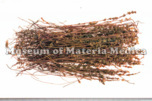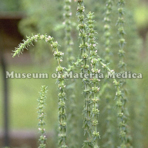Schizonepeta Spike

|
Market name:荊芥 Photo location:Museum of Materia Medica, Inst. of Nat. Med. TMPW No.:2261 |

|
Plant name:Schizonepeta tenuifolia Photo location:Gifu Pref., Japan Photo date:1988 Photographer:K. Komatsu |
| Synonym | |
| Latin name | Schizonepetae Spica |
| Botanical source: Family name | Labiatae |
| Botanical source: Plant name | Schizonepeta tenuifolia Briquet (IPNI:458037-1) |
| Part used | Pedunculus with spikes or branches with spikes, or spikes |
| Empirical criteria for quality selection | Good one is fresh and has a strong aroma (TN). |
| Constituents | Other aliphatic and related compounds: 3-Octanone, 3-Octanol, 1-Octen-3-ol Monoterpenoids: Essential oil 1.8%: d-Menthone, l-Menthone, d-Limonene, l-Pulegone, l-Isomenthone, Isopulegone, α-Pinene, β-Pinene, Camphene, Piperitone, Piperitenone, Schizo-nepetoside A, Schizo-nepetoside B, Schizonepetoside C, Schizo-nepetoside D, Schizo-nepetoside E Sesquiterpenoids: Caryophyllene, β-Elemene, β-Humulene Flavones & Flavonols: Diosmetin, Hesperetin, Luteolin |
| Pharmacological effects | Slight antipyretic, antipruritus, antibacterial (tubercle bacillus). |
| Indications | As a diaphoretic, antifebrile, carminative, antispasmodic and hemostatic, it is applied to treat early stage of cold, headache, sore throat, wound, skin disease, disorder of after childbirth, hematemesis, epistaxis, hematochezia and metrorrhagia and metrostaxis. |
| Diseases | Common cold, Chill, Fever, Headache, Sore throat, Measles, Rubella, Itching, Pyogenic dermatosis, Hematemesis, Nasal hemorrhage, Hematochezia |
| Formulas | kufugedokusan , keigairengyoto , keibohaidokusan , gomotsugedokusan , shofusan , jumihaidokuto , seijobofuto , senkanmeimokuto , senkyuchachosan , jizusoippo , jizusoippokyodaio , tokiinshi , bofutsushosan |
| Meridian tropism | Lung, Liver |
| Property | Slightly warm |
| Flavor | Acrid/pungent |
| Classification in "Shen-non Ben-cao Jing" | Middle |
| TCM: Classification | Diaphoretics (Diaphoretics with warm property) |
| TCM: Medicinal effects | To induce diaphoresis, to dispel wind, and to promote eruptions. Use for common cold, headache, measles, rubella and sores at the early stage. Carbonized Herba Schizonepetae: Hematochezia, abnormal uterine bleeding, and fainting after delivery due to excessive bleeding. |
| Remarks | Listed in the Japanese Pharmacopoeia 18th ed. |
| References | TN: T. Namba & Y. Tsuda ed., Outline of Pharmacognosy, a Textbook, 3rd ed., Nankodo Co., Ltd., Tokyo, 1998. |
DNA sequences of medicinal plants
| Gene Region | |||||||||||||||||||
| Nuclear | Chloroplast | Mitochondria | |||||||||||||||||
| Botanical source: Plant name | 5Ss | 18S | ITS1 | 5.8S | ITS2 | 26S | others | trnH-psbA | matK | trnK | trnK-rps16 | trnT-L | trnL | trnL-F | rbcL | rpoC1 | ndhF | others | |
|
|
|||||||||||||||||||
